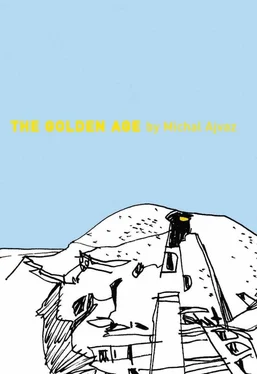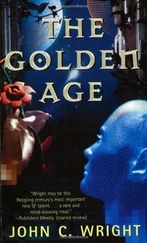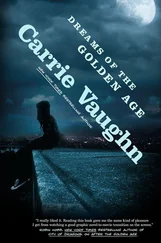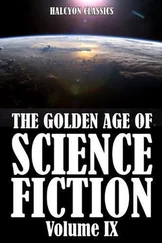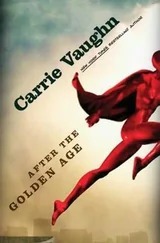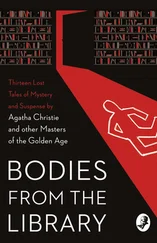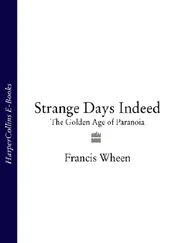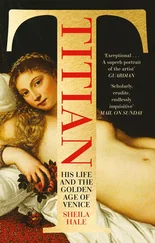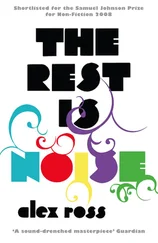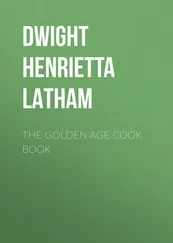Michal Ajvaz - The Golden Age
Здесь есть возможность читать онлайн «Michal Ajvaz - The Golden Age» весь текст электронной книги совершенно бесплатно (целиком полную версию без сокращений). В некоторых случаях можно слушать аудио, скачать через торрент в формате fb2 и присутствует краткое содержание. Год выпуска: 2010, Издательство: Dalkey Archive Press, Жанр: Современная проза, на английском языке. Описание произведения, (предисловие) а так же отзывы посетителей доступны на портале библиотеки ЛибКат.
- Название:The Golden Age
- Автор:
- Издательство:Dalkey Archive Press
- Жанр:
- Год:2010
- ISBN:нет данных
- Рейтинг книги:4 / 5. Голосов: 1
-
Избранное:Добавить в избранное
- Отзывы:
-
Ваша оценка:
- 80
- 1
- 2
- 3
- 4
- 5
The Golden Age: краткое содержание, описание и аннотация
Предлагаем к чтению аннотацию, описание, краткое содержание или предисловие (зависит от того, что написал сам автор книги «The Golden Age»). Если вы не нашли необходимую информацию о книге — напишите в комментариях, мы постараемся отыскать её.
is Michal Ajvaz’s greatest and most ambitious work.
The Golden Age
The Golden Age — читать онлайн бесплатно полную книгу (весь текст) целиком
Ниже представлен текст книги, разбитый по страницам. Система сохранения места последней прочитанной страницы, позволяет с удобством читать онлайн бесплатно книгу «The Golden Age», без необходимости каждый раз заново искать на чём Вы остановились. Поставьте закладку, и сможете в любой момент перейти на страницу, на которой закончили чтение.
Интервал:
Закладка:
The lexicons of stains had been lost and the islanders had forgotten about them, but the categories that had their origins in these books had left a deep impression in the islanders’ language and ways of seeing. Stains of different shapes belong to different types; for the islanders they are as different in kind as a chair and a table are to us. Although on the island a great many instruments — many of them objects connected with civilization — are missing that we have by us constantly, the islanders are surrounded by a far greater amount of things than we are. The islanders live among stains as we live among objects and letters. Indeed, they feel more at home in expanses of stains than in the world of objects; for them, stains have more of an existence than ordinary objects. While we compare stains to objects and bodies and say things like, “Hey, look at that stain! It looks like a walrus,” when the islanders want to describe the shape of an object — let’s say a ship that has just appeared in the harbour — they say, “It looks like a tnaeb.” A tnaeb is an oblong, saggy stain with a number of outgrowths on its upper side. The islanders look at the world of objects and bodies as at a Rorschach-type test turned inside out.
The categorizing of stains is embedded so deeply in the consciousness of the islanders that not only do they seek to compare the shapes of objects with those of stains, but types of stains play a role — consciously or unconsciously — when objects come into being. There are many household objects and buildings on the island that are in the shape of a stain, not least being the escutcheons on mansions and palaces of the lower town built in the final phase of building activity that imitate the shapes of various types of stains. It was instructive for me to study the architecture of the conquerors from the time they were already losing the war against the spirit of the islanders; from these it was plain that the shapes of stains had infiltrated the visions of the architects — for example, the facade of a church obviously meant to be a replica of Rome’s Jesuit Church of the Gesu was far more reminiscent of the mark amamr. I can well imagine the dejection of the church’s architect when he realized this result of his work.
It was a blasphemy to glorify the god of the stain (a god who accepted such devotion would transform into another deity), and it was not possible to run away from a stain. The islanders’ stains lay in wait for the builders like cunning beasts of prey; not only did they reside in the dark gaps between shapes (these spaces could have been left as a kind of reservation), but they stole into the seemingly secure territory of recognized shapes and caused much damage there. They destroyed recognized shapes and appointed themselves in their place, or at the very least the stains so bedevil-led and confused the recognized shapes that these began to imitate stains. The capitals of pilasters and the volutes of escutcheons could not resist the urge to become grm or mupu stains. Even the figures of saints became images and statues of stains; they were unable to deliver salvation, or — worse still — they offered a terrible salvation, the monstrous paradise of stains.
It was pathetic to watch the desperate attempts of the architects to escape the stains that pursued them, which were more terrifying to them than the monsters of mythology. I often felt the facades of the houses told of their builders’ fear of a terrible, debilitating sickness, which we might name the impossibility of the indefinite. Indefiniteness and shapelessness were forever escaping them, because every accidental splatter of mortar immediately became an irao or a ladoe; when they wanted to escape an ede that had grown right under their hands, they found it turning into an alopo. Perhaps it seems strange that they were so keen to preserve the shapeless, the indefinite, the nameless and the patternless. Most of all the builders looked for shapelessness to salvage the world of shapes; shapes needed indefinite, discreet matter to which they could give their orders and which would serve them. When a shape on the island entered matter, what it found there was not calm complaisance but the frenzied proliferation of figures, and in this uncomfortable jungle it could not find a place to settle. It was used in overcoming the resistance of matter, but here its power and solidity were worth nothing; here matter was so apathetic that it put up no resistance to shapes, but it pulled them into its whirling dance and enfeebled it by its toxic breath. The worst thing of all about this was that the monstrous and offensive stain figures constantly putting themselves in the paths of shapes were uncannily similar to these shapes and thus familiar to them. When the shapes discovered the reason for this, they were horrified: it was not that stains were imitating shapes and wished to take their place, but that shapes were of the same genus as stains and had forgotten the world they were born into, that they were just as phantasmic and monstrous as stains, that shapes and stains were the same fruit of the wild proliferation of matter, meaning that shapes were afforded no privileges.
We know how the anguished battle between the foreigners and the demons of the island ended. After a long period of unbearable strain the foreigners yielded, and this yielding was made manifest in their attitude to the danger posed by stains. In a sudden flood of bliss the foreigners were plunged into a paradise they had long yearned for but had been afraid to admit to. In the lower town, buildings from the time of blissful defeat have been preserved; they reveal how their architects revelled in the once-forbidden depravity of stains, how they luxuriated in the stains that had eluded them for many years, how in triumph they allowed them to dominate the island and declare the Collapse of Shape.
The master from Berlin
Perhaps, dear reader, you think that as I write my mind is filled with visions of the island, that nothing is important to me except the efforts to fish out of memory clearly-drawn pictures of the landscape of the island. Perhaps you think I consider you a remote figure, unreal or bothersome, a figure that disturbs my dreams and at whose behest I have to demean and exert myself by transferring glowing images into dark, clumsy words, to bind in the manacles of grammar and syntax the free, light motions of the waves, sands, and winds that linger in my memory. Perhaps you think that because of this I hate you, that I consider you the agent of my misfortune, that I sit at my computer keyboard — whose gentle tapping beneath my fingers is transformed into the sounds of gravel underfoot on the scorched paths of the island’s rocks — hatching plans which do you harm, which use language to ensnare you.
How mistaken you are, dear reader! I think of you continually; I am grateful to you that our conversation allows me to inject by sharp, angular words at least a flickering glow in the faded images. It is your face that I see in the gaps between all words, I am forever anxious for your comfort, I worry that the reading I ask of you is boring you. I would be happier if this travelogue were sold in a box containing items to supplement the reading matter — a fine-woven hammock, a bottle of a sweet liqueur, flacons, Oriental sweetmeats; you would read the book stretched out comfortably in the hammock, nibbling on Turkish delight and sipping the liqueur, the air would be scented with essence of cedarwood and myrrh; in fact, I would even offer my services for free for the packing of these boxes.
When I told you that nothing ever happened on the island, I suspect you did not believe me; you thought that I was exaggerating, that there was surely a tale of excitement to come. In this I am afraid I have to disappoint you: it really is the case that you will encounter nothing like this in the whole book. I suppose I could invent something, tell you of fights with vicious beasts, of the discovery of precious carvings in a sunken gallery, of the stirring of a volcano, of the remnants of an ancient cult of magic into which I was initiated, of mysterious apparitions in the hot, empty streets of the lower town…But I really want to tell you the truth, which is that in the three years I spent on the island, nothing happened; nor had anything interesting happened there in all the centuries since the European conquest. But when — thinking of you — I sat down at my computer this morning, an idea came to me: if you are so anxious to have a story, I can at least finish that of the Czech emigrant in Paris. Now it seems to me I was too harsh on you in refusing to say any more about the theft of the necklace. Let us return to Paris; perhaps you remember that we left Baumgarten sitting next to the cat-burglar — whose life he had just saved — on the snow-covered roof, perched on the neon letter “a.”
Читать дальшеИнтервал:
Закладка:
Похожие книги на «The Golden Age»
Представляем Вашему вниманию похожие книги на «The Golden Age» списком для выбора. Мы отобрали схожую по названию и смыслу литературу в надежде предоставить читателям больше вариантов отыскать новые, интересные, ещё непрочитанные произведения.
Обсуждение, отзывы о книге «The Golden Age» и просто собственные мнения читателей. Оставьте ваши комментарии, напишите, что Вы думаете о произведении, его смысле или главных героях. Укажите что конкретно понравилось, а что нет, и почему Вы так считаете.
